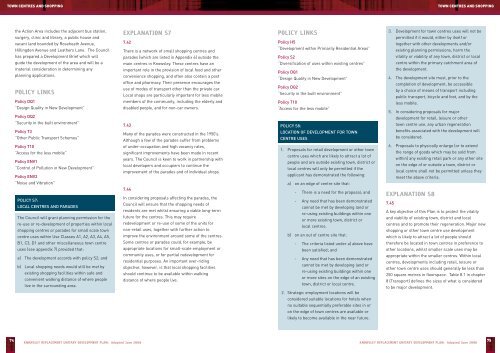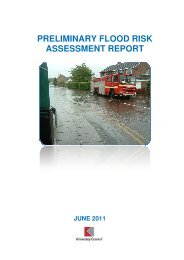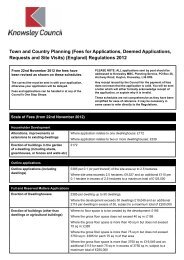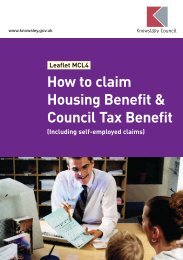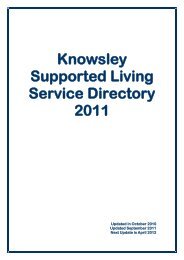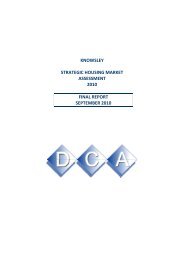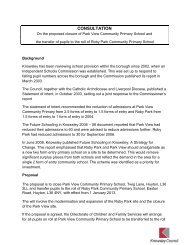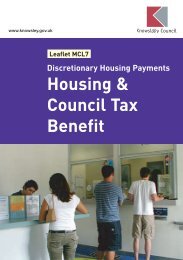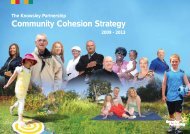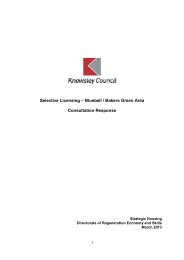Knowsley Replacement Unitary Development Plan - Knowsley Council
Knowsley Replacement Unitary Development Plan - Knowsley Council
Knowsley Replacement Unitary Development Plan - Knowsley Council
Create successful ePaper yourself
Turn your PDF publications into a flip-book with our unique Google optimized e-Paper software.
TOWN CENTRES AND SHOPPING<br />
TOWN CENTRES AND SHOPPING<br />
the Action Area includes the adjacent bus station,<br />
surgery, clinic and library, a public house and<br />
vacant land bounded by Roseheath Avenue,<br />
Hillingden Avenue and Leathers Lane. The <strong>Council</strong><br />
has prepared a <strong>Development</strong> Brief which will<br />
guide the development of the area and will be a<br />
material consideration in determining any<br />
planning applications.<br />
POLICY LINKS<br />
Policy DQ1<br />
“Design Quality in New <strong>Development</strong>”<br />
Policy DQ2<br />
“Security in the built environment”<br />
Policy T3<br />
“Other Public Transport Schemes”<br />
Policy T10<br />
“Access for the less mobile”<br />
Policy ENV1<br />
“Control of Pollution in New <strong>Development</strong>”<br />
Policy ENV2<br />
“Noise and Vibration”<br />
POLICY S7:<br />
LOCAL CENTRES AND PARADES<br />
The <strong>Council</strong> will grant planning permission for the<br />
re-use or re-development of properties within local<br />
shopping centres or parades for small scale town<br />
centre uses within Use Classes A1, A2, A3, A4, A5,<br />
B1, C3, D1 and other miscellaneous town centre<br />
uses (see appendix 7) provided that:<br />
a) The development accords with policy S2; and<br />
b) Local shopping needs would still be met by<br />
existing shopping facilities within safe and<br />
convenient walking distance of where people<br />
live in the surrounding area.<br />
EXPLANATION S7<br />
7.42<br />
There is a network of small shopping centres and<br />
parades (which are listed in Appendix 6) outside the<br />
main centres in <strong>Knowsley</strong>. These centres have an<br />
important role in the provision of local food and other<br />
convenience shopping, and often also contain a post<br />
office and pharmacy. Their presence encourages the<br />
use of modes of transport other than the private car.<br />
Local shops are particularly important for less mobile<br />
members of the community, including the elderly and<br />
disabled people, and for non-car owners.<br />
7.43<br />
Many of the parades were constructed in the 1950’s.<br />
Although a few of the parades suffer from problems<br />
of under-occupation and high vacancy rates,<br />
significant improvements have been made in recent<br />
years. The <strong>Council</strong> is keen to work in partnership with<br />
local developers and occupiers to continue the<br />
improvement of the parades and of individual shops.<br />
7.44<br />
In considering proposals affecting the parades, the<br />
<strong>Council</strong> will ensure that the shopping needs of<br />
residents are met whilst ensuring a viable long-term<br />
future for the centres. This may require<br />
redevelopment or re-use of some of the units for<br />
non-retail uses, together with further action to<br />
improve the environment around some of the centres.<br />
Some centres or parades could, for example, be<br />
appropriate locations for small-scale employment or<br />
community uses, or for partial redevelopment for<br />
residential purposes. An important over-riding<br />
objective, however, is that local shopping facilities<br />
should continue to be available within walking<br />
distance of where people live.<br />
POLICY LINKS<br />
Policy H5<br />
“<strong>Development</strong> within Primarily Residential Areas”<br />
Policy S2<br />
“Diversification of uses within existing centres”<br />
Policy DQ1<br />
“Design Quality in New <strong>Development</strong>”<br />
Policy DQ2<br />
“Security in the built environment”<br />
Policy T10<br />
“Access for the less mobile”<br />
POLICY S8:<br />
LOCATION OF DEVELOPMENT FOR TOWN<br />
CENTRE USES<br />
1. Proposals for retail development or other town<br />
centre uses which are likely to attract a lot of<br />
people and are outside existing town, district or<br />
local centres will only be permitted if the<br />
applicant has demonstrated the following:<br />
a) on an edge of centre site that:<br />
- There is a need for the proposal; and<br />
- Any need that has been demonstrated<br />
cannot be met by developing land or<br />
re-using existing buildings within one<br />
or more existing town, district or<br />
local centres.<br />
b) on an out of centre site that:<br />
- The criteria listed under a) above have<br />
been satisfied; and<br />
- Any need that has been demonstrated<br />
cannot be met by developing land or<br />
re-using existing buildings within one<br />
or more sites on the edge of an existing<br />
town, district or local centre.<br />
2. Strategic employment locations will be<br />
considered suitable locations for hotels when<br />
no suitable sequentially preferable sites in or<br />
on the edge of town centres are available or<br />
likely to become available in the near future.<br />
3. <strong>Development</strong> for town centres uses will not be<br />
permitted if it would, either by itself or<br />
together with other developments and/or<br />
existing planning permissions, harm the<br />
vitality or viability of any town, district or local<br />
centre within the primary catchment area of<br />
the development.<br />
4. The development site must, prior to the<br />
completion of development, be accessible<br />
by a choice of means of transport including<br />
public transport, bicycle and foot, and by the<br />
less mobile.<br />
5. In considering proposals for major<br />
development for retail, leisure or other<br />
town centre use, any urban regeneration<br />
benefits associated with the development will<br />
be considered.<br />
6. Proposals to physically enlarge (or to extend<br />
the range of goods which may be sold from<br />
within) any existing retail park or any other site<br />
on the edge of or outside a town, district or<br />
local centre shall not be permitted unless they<br />
meet the above criteria.<br />
EXPLANATION S8<br />
7.45<br />
A key objective of this <strong>Plan</strong> is to protect the vitality<br />
and viability of existing town, district and local<br />
centres and to promote their regeneration. Major new<br />
shopping or other town centre use development<br />
which is likely to attract a lot of people should<br />
therefore be located in town centres in preference to<br />
other locations, whilst smaller scale uses may be<br />
appropriate within the smaller centres. Within local<br />
centres, developments including retail, leisure or<br />
other town centre uses should generally be less than<br />
250 square metres in floorspace. Table 8.1 in chapter<br />
8 (Transport) defines the sizes of what is considered<br />
to be major development.<br />
74<br />
KNOWSLEY REPLACEMENT UNITARY DEVELOPMENT PLAN: Adopted June 2006<br />
KNOWSLEY REPLACEMENT UNITARY DEVELOPMENT PLAN: Adopted June 2006<br />
75


